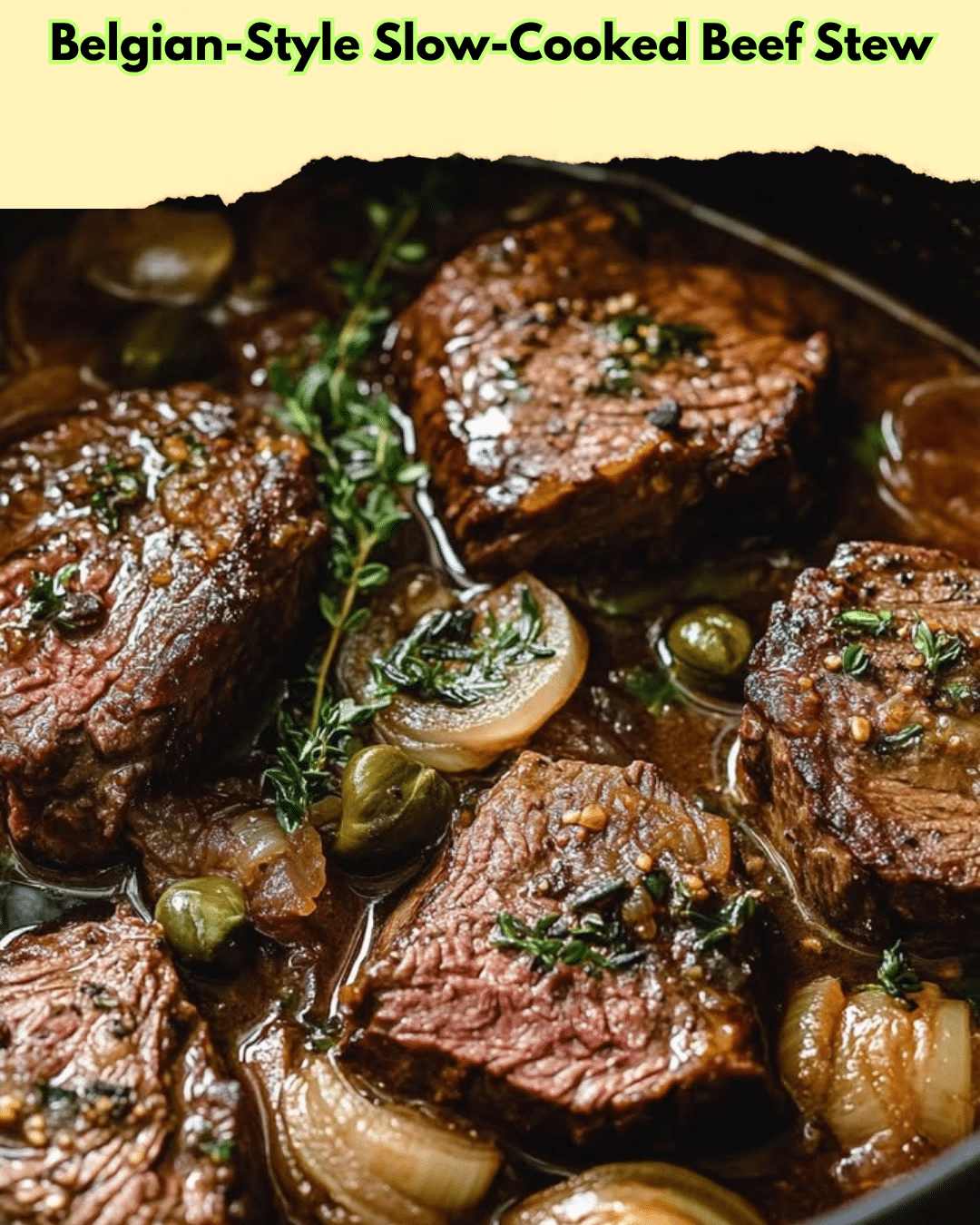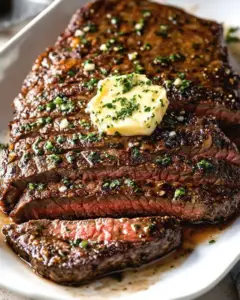Belgian-Style Slow-Cooked Beef Stew: A Heartwarming Delight
Belgian-style slow-cooked beef stew, known as “Carbonnade Flamande,” is a comforting dish perfect for those cozy evenings when you crave something hearty and satisfying. This stew combines tender beef, rich broth, and flavorful beer, creating a symphony of taste that warms your soul. Imagine biting into a piece of succulent beef that melts in your mouth, enriched by the depth of a well-crafted Belgian beer. The caramelized onions add sweetness, balancing the savory tastes, making each bite a delightful experience. Complemented by its enticing aroma, this slow-cooked beef stew invites everyone to the table, ensuring moments of conviviality and warmth.
Quick Recipe Highlights
- Flavor Profile: The stew features a sweet and savory balance with hints of mustard and thyme. The beer adds a subtle bitterness that complements the caramelized onions and tender beef.
- Texture: Each piece of beef is fall-apart tender, while the sauce is thick and rich, coating every ingredient generously.
- Aroma: Expect a delightful blend of beefy richness with hints of beer and spices, evoking a sense of traditional slow-cooked meals.
- Visual Appeal: The stew boasts a deep brown color with vibrant orange carrots and green thyme sprigs providing contrast, making it visually appetizing.
- Skill Level Needed: While the stew requires patience, its straightforward process makes it accessible to novice and experienced cooks alike.
- Special Equipment: A slow cooker or Dutch oven is essential to achieve the perfect simmer and flavor development in your beef stew.
Recipe Overview
- Difficulty Level: The medium difficulty is due to the need for proper meat browning and careful timing of ingredient additions. Those familiar with slow cooking will find the process gratifying and straightforward.
- Category: This stew falls under the comfort food category, ideal for hearty dinners and robust lunch servings, especially on cooler days.
- Cuisine: Rooted in Belgian culinary tradition, this dish embodies the country’s love for beer and meat, infusing each with local spices and flavors.
- Cost: As a cost-effective meal, the main expenses are the beef and beer, but these yield enough servings to be economical for gatherings.
- Season: Best enjoyed during fall and winter months when the comforting warmth of a stew aligns perfectly with cooler weather.
- Occasion: Ideal for Sunday family lunches, holiday feasts, or any gathering where hearty dishes shine and warm conversations flow.
Why You’ll Love This Recipe
The taste and texture of this Belgian-style slow-cooked beef stew are nothing short of comforting. The beef becomes tender and succulent, absorbing the beer’s deep flavor and spice mixture. The rich, savory sauce envelops every bite, creating an irresistible mouthfeel. The straightforward preparation is a boon for busy individuals who appreciate hands-off cooking methods like slow-cooking. Simply setting the ingredients to cook and walking away makes it a convenient choice for those with bustling schedules. On the nutritional front, the beef stew is high in protein and iron, while onions and beer provide antioxidants and B vitamins. It’s a delightful dish with a well-rounded nutritional profile.
This dish is perfect for social gatherings, as it feeds a crowd easily and can be made ahead, allowing the host to enjoy their guests instead of being stuck in the kitchen. Its comforting aroma and hearty nature encourage conversation and communal enjoyment around the table. In terms of cost-effectiveness, utilizing cost-effective beef cuts and pantry staples makes this a budget-friendly option that’s both filling and impressive. Moreover, the adaptable nature of the recipe allows for ingredient substitutions, making it accessible across various dietary preferences and ingredient availability.
Historical Background and Cultural Significance
The origin of the Belgian-style slow-cooked beef stew, carbonnade flamande, lies in the heart of Belgium’s gastronomic history, where it’s known as a staple in Flemish cuisine. Traditionally, this dish was crafted using local ingredients readily available to villagers, such as beef and beer, and was slowly cooked to ensure tender and flavorful results. Its cultural importance reflects Belgium’s deep-rooted appreciation for hearty, communal meals shared among family and friends. Over time, this traditional dish has gained popularity beyond Belgian borders, celebrated for its rich flavors and satisfying nature. The recipe’s evolution has seen various adaptations, incorporating regional beers and seasonal vegetables to suit local tastes.
Regional variations of this stew demonstrate Belgium’s diverse beer culture; different regions might use their locally brewed beer to impart distinct flavors. Some areas prefer a sweeter finish by using a beer with a higher sugar content, whereas others opt for a more robust, bitter profile. Regardless of these variations, the essence of Belgian-style slow-cooked beef stew remains the same: a dish that brings people together over its comforting warmth and richness.
Ingredient Deep Dive
Beef is the cornerstone of this Belgian-style stew, traditionally using cuts like chuck for its ideal balance of flavor and tenderness. Historically, beef was a luxury in many households, symbolizing wealth and hospitality when served. Nutritionally, beef provides high protein content, essential amino acids, and beneficial minerals like iron and zinc. When selecting beef, choose cuts with good marbling to ensure both flavor and tenderness during the slow-cook process. Store beef refrigerated for up to three days or freeze for longer storage to maintain freshness.
Beer plays a dual role, both enhancing flavor and tenderizing the beef. Belgian brown or dark ales are traditionally used, adding depth with subtle notes of caramel, spice, and bitterness. Selection is key: choose a beer with balanced sweetness and bitterness to enrich the overall dish without overpowering it. Store beer in a cool, dark place until ready to use. If necessary, substitute with a broth or a non-alcoholic beer to mimic flavor without alcohol.
Common Mistakes to Avoid
- Overcrowding the pot can lead to steaming rather than browning the meat, so ensure adequate space when browning the beef.
- Skipping the browning step reduces flavor depth, as caramelized surfaces contribute significantly to the stew’s richness.
- Using the wrong beer type can result in undesirable flavor profiles; stick to brown ales or similar for best results.
- Adding too much liquid might result in a watery stew, so adhere to recommended liquid quantities for a thick, rich sauce.
- Stirring too vigorously may break up the tender meat chunks; handle with care to maintain texture.
- Undercooking results in tough beef pieces; ensure the weather and time allow for full cooking for optimal tenderness.
- Ignoring seasoning adjustments mid-cook can lead to imbalance; taste periodically and season as needed throughout cooking.
- Not allowing the stew to rest post-cooking can lead to flavor loss; let it sit for at least 15 minutes for full flavor development.
Essential Techniques
Browning the beef creates flavor foundations through the Maillard reaction, caramelizing the meat’s exterior. This process adds a depth of flavor pivotal to enhancing the stew’s richness. Mastering this technique involves patience; wait for the pan and oil to properly heat before adding the beef to avoid steaming. Avoid over-stirring, which breaks the Maillard crust, and instead, let the beef sear undisturbed until perfectly browned. Visual cues include deeply colored edges and a nutty aroma, indicating successful browning and readiness for the next step.
Sautéing vegetables like onions ensures they release their natural sugars, enriching the stew with sweetness and caramel notes. Ensure onions are fully translucent and slightly golden, indicating readiness. Overcrowding the pan here, too, can impede browning, so give vegetables space to breathe and cook evenly. One might need to work in batches depending on the pot size to achieve the right texture and flavor profiles.
Deglazing the pot with beer is essential for capturing the fond, or browned bits, at the pan’s bottom—the heart of flavor development in stews. This technique not only lifts these bits into the liquid but also incorporates the aromatic nuances of your beer. Use a wooden spoon or spatula to gently scrape the pot’s bottom during de-glazing. A successful deglaze presents a uniform liquid color with no bits stuck to the pan.
Pro Tips for Perfect Belgian-Style Slow-Cooked Beef Stew
Select a well-marbled beef cut like chuck; the marbling transforms into succulence during slow cooking. Use room-temperature ingredients to ensure even cooking and to avoid unnecessary cooling of the pot as ingredients are added. Incorporate fresh herbs during the last stages of cooking for pronounced flavor without bitterness from overcooking. Consider marinating the beef in beer overnight for extra depth and tenderness before cooking to save time on prep day. Use a heavy-bottomed pot, such as a Dutch oven, to ensure even heat distribution during the slow-cooking phase. Allow the stew to sit uncovered for a short period after cooking to thicken the sauce naturally as it cools. Balance the sweetness of onions with a touch of vinegar or lemon juice, enlightening the stew without overshadowing the rich base.
Variations and Adaptations
In various Belgian regions, different beers are used to alter the stew’s flavor profile—a Trappist ale adds a fruity richness, while a lambic imparts more tartness. Seasonal adaptations can include adding root vegetables like parsnips or turnips during fall and winter to enhance the stew’s hearty nature. For dietary modifications, replace flour used in thickening with a gluten-free alternative, or substitute beef broth for the beer to accommodate preferences. Adding mushrooms for an umami twist offers an additional dimension of texture and flavor, while a splash of cream introduces a creamy, luscious mouthfeel. Presentation alternatives could focus on serving the stew in individual bowls garnished with fresh herbs, providing a rustic yet sophisticated look.
Serving and Presentation Guide
For a classic presentation, serve the stew over mashed potatoes, allowing the creamy potatoes to soak up the rich sauce. Garnishing with fresh thyme sprigs enhances both the visual and aromatic appeal. Traditional accompaniments like crusty bread or a side of belgian frites (fries) offer a delightful crunch contrasting the stew’s tenderness. Modern serving suggestions swap the mashed potatoes for creamy polenta or couscous, introducing variety while keeping within the same comfort theme. Consider the stew’s temperature: serving it warm ensures the sauce remains thick and luxurious. Portion control tips advise serving 1 to 1.5 cups per person, given the stew’s density and richness.
Wine and Beverage Pairing
Accompany this Belgian-style beef stew with a complementary full-bodied red wine, such as a French Burgundy or an Argentinian Malbec. Both choices have the tannins to match the stew’s richness while enhancing the beef’s flavor with their dark fruit notes. Non-alcoholic alternatives could include a rich, malty root beer that mimics the depth brought by Belgian ales. If coffee or tea is on the menu, consider a robust dark roast or a black tea with enough body to match the stew’s depth. Temperature considerations suggest serving drinks slightly warmer than typical—a soft warmth can echo the stew’s coziness.
Storage and Shelf Life
Store leftovers in airtight containers in the refrigerator for up to three days to maintain quality. Ensure the stew is cooled to room temperature before refrigerating to prevent condensation and subsequent thinning of the sauce. Freezing is an option for longer storage; freeze in portion-controlled containers for up to three months, allowing for easy defrosting and reheating. If reheating, avoid boiling, which can lead to a tough texture—opt instead for gentle, slow reheating over low heat to maintain meat tenderness. Monitor signs of spoilage, such as off-odors or color changes. Invest in heavy-duty freezer bags to prevent freezer burn during storage.
Make-Ahead Strategies
For maximum efficiency, prep ingredients the day before; chop vegetables and marinate beef to enmesh flavors overnight. If assembling in advance, arrange ingredients in the slow cooker and refrigerate, bringing to room temperature before cooking. When storing between steps, seal components to prevent moisture loss or cross-flavors from melding inappropriately. Assess quality impacts; flavors deepen over time, enhancing stew’s complexity when made in advance. Post-assembly, reheat per recommendations, and freshen with chopped herbs or a dash of citrus before serving for a vibrancy boost.
Scaling Instructions
To halve, reduce all ingredient amounts proportionally, taking care to maintain aspect ratios for liquid and solids. When doubling or tripling, the main adjustments involve pot size; ensure ample space for ingredients to cook evenly without steaming. Larger quantities might adjust timing slightly, extending the cook time to ensure all portions reach the desired tenderness. Increased quantities require careful storage and reheating procedures; consider splitting into several containers for efficiency.
Nutritional Deep Dive
Boasting a balanced macro profile, this stew provides ample protein, making it satisfying and muscle-supportive, especially after a strenuous day. The micronutrients include iron, critical for energy production, and vitamins B3 and B12 from both beef and beer, supporting overall metabolism. Health benefits include potentially improved cardiovascular function due to this stew’s nutrient profile. Portion analysis highlights its suitability as a main meal, providing satiation with fiber and protein packed into every serving. For those mindful of weight, adopting smaller serving sizes or pairing with lighter side dishes can maintain meal balance effectively.
Dietary Adaptations
For a gluten-free version, ensure that the beer and any thickening agents used comply with gluten-free standards. To create a dairy-free stew, focus on browning meat and vegetables using olive oil or another neutral oil instead of butter. A vegan adaptation is conceivable by substituting beef with mushroom or tofu alternatives, using vegetable broth and non-alcoholic beer. A low-carb preference might eliminate root vegetables, focusing on mushrooms and bell peppers to lower overall carbohydrate intake. Keto diners can appreciate a double serving of the protein-rich beef while maintaining similar flavor profiles with keto-approved substitutes. Those following a paleo plan can create hearty flavors using compliant oils, homemade bone broth, and alcohol-free recipes. Suitable low-FODMAP options replace ingredients like onions and garlic, adopting sturdy substitutions, ensuring those with sensitivities enjoy their meal without distress.
Troubleshooting Guide
Address potential texture issues by ensuring the appropriate cooking time is met; uneven or rushed cooking can leave beef chewy. If the flavor lacks balance, incorporate a dash of acidity, such as vinegar, to brighten the taste profile or add depth with more seasoning. Temperature management is crucial; excessive boiling can toughen meat or mess with stew consistency—keep to low, slow cooking. In the presence of equipment challenges, a heavy-bottom pot or alternate slow cooking method can fill in if an electric cooker is unavailable. Substitutions for uncommon ingredient options may include swapping beer types or herbs to suit availability while keeping core flavors intact.
A trusty approach to timing concerns involves a staggered ingredient addition technique, ensuring everything cooks to its intended doneness without losing integrity—monitor each step for visual and textural cues.
Recipe Success Stories
Our community applauds the traditional Belgian-style slow-cooked beef stew for its comforting elements seamlessly brought together. Feedback reveals successful attempts across varying levels of expertise, with some readers recalling family connections reignited through shared meals. Variations have prompted creativity; some swapped in lamb for a richer profile or incorporated alternative root vegetables available locally, resulting in unique culinary spins on this beloved classic. Suggestions from readers detailed moments of triumph with home-grown herbs or local brews, imparting personal touches to their dishes—echoes of community-centric contentment.
Photography tips shared often recommend focusing on detailed garnishing for eye-catching presentations, capturing the stew’s warmth and array of colors through appropriate lighting.
Frequently Asked Questions
Yes, beef or vegetable broth can replace beer to retain moisture and flavor without alcohol. Opt for varieties with rich, deep profiles for best results.
How do I thicken the stew?
Common approaches include the addition of a flour paste or pureed vegetables, but cornstarch or arrowroot offers gluten-free alternatives.
How long can leftovers be stored?
In the fridge, consume within three days ideally; freezing extends life to approximately three months, maintaining texture and flavor.
What’s the best way to reheat?
Gentle reheating over low heat is advised, preventing the stew from boiling, which can cause changes in texture and quality.
Can I use a different protein?
Yes, proteins such as pork or poultry offer alternatives with complementary profiles, though cooking times change depending on choice and size.
Is this recipe suitable for a slow cooker?
Absolutely. It’s ideal for slow cookers, aligning with their strengths in retaining moisture and developing robust flavors over time.
Can I prepare this stew ahead of time?
Yes, flavors deepen beautifully when prepared in advance, offering make-ahead convenience, perfect for busy schedules or large gatherings.
Is there a low-sodium option?
Select low-sodium broths or limit additional salt intake. Natural seasoning alternatives like fresh herbs elevate flavors without added sodium.
What sides pair with this stew?
Traditional pairings include mashed or roasted potatoes, crusty bread, or a simple mixed green salad, all enhancing the delicious richness of the stew.
Will this stew freeze well?
Yes, providing a hearty option ready at a moment’s notice. Ensure proper portioning and airtight container use during freezing to maintain quality.
How can it be customized for spice?
For spice, add a pinch of cayenne or smoked paprika for depth without overwhelming the stew’s traditional flavor profile.
Additional Resources
For those inspired by the Belgian-style stew to explore more, consider related recipes that expand on Flemish comfort food traditions. Technique guides focusing on browning and deglazing enhance culinary practice stages, improving future cooking engagements. Ingredient information is crucial in broadening understanding of core elements like beer and its regional influences. Equipment recommendations like opting for Dutch ovens ensure proper heat retention and flavor development during long cooks. Seasonal variations of classic stews demonstrate how adjustments celebrate each regional produce and seasonal shift, promoting both creativity and locality in cuisine.
Print
Belgian-Style Slow-Cooked Beef Stew
Description
A hearty and savory beef stew, slow-cooked to perfection with a touch of Belgian flavor.
Ingredients
For the Crust:
- 2 lbs beef stew meat, cut into 1-inch cubes
- 2 tablespoons vegetable oil
- 2 onions, sliced
- 2 cloves garlic, minced
- 2 cups beef broth
- 1 cup Belgian beer
- 2 tablespoons tomato paste
- 1 tablespoon brown sugar
- 1 tablespoon Worcestershire sauce
- 1 teaspoon dried thyme
- 2 bay leaves
- Salt and pepper to taste
Instructions
1. Prepare the Crust:
- Heat the vegetable oil in a large pot over medium-high heat. Brown the beef cubes on all sides, then remove from the pot and set aside.
- In the same pot, add the onions and garlic, and cook until softened, about 5 minutes.
- Return the beef to the pot and add the beef broth, beer, tomato paste, brown sugar, Worcestershire sauce, thyme, bay leaves, salt, and pepper. Stir well and bring to a boil.
- Reduce the heat to a simmer, cover the pot, and cook for 2 to 2.5 hours or until the beef is tender.
Notes
You can customize the seasonings to taste.




